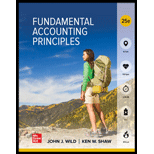
FUND.ACCT.PRIN.
25th Edition
ISBN: 9781260247985
Author: Wild
Publisher: RENT MCG
expand_more
expand_more
format_list_bulleted
Question
Chapter 17, Problem 21QS
To determine
Concept Introduction: Unusual gain or loss is an abnormal gain or loss, unrelated to ordinary business operations. It is both unusual and infrequent. IFRS treat income or expense that are unusual as non-recurring item. Under GAAP, unusual items are either reported in financial statements or disclosed in notes to financial statements.
The given gain or losses are unusual or infrequent.
Expert Solution & Answer
Want to see the full answer?
Check out a sample textbook solution
Students have asked these similar questions
A business started the year with inventory worth $35,000. During the year, it purchased additional inventory for $150,000 and ended the year with inventory valued at $42,000. What was the cost of goods sold for the year?
Given solution for General accounting question not use ai
Granada Company uses the weighted-average method in its process costing system. The first processing department, the Mixing Department, started the month with 20,000 units in its beginning work in process inventory that were 40% complete with respect to conversion costs. The conversion cost in this beginning work-in-process inventory was $32,000. An additional 100,000 units were started into production during the month and 95,000 units were completed in the Mixing Department and transferred to the next processing department. There were 25,000 units in the ending work-in-process inventory of the Mixing Department that were 30% complete with respect to conversion costs. A total of $518,000 in conversion costs were incurred in the department during the month. What would be the cost per equivalent unit for conversion costs for the month? A. $4.89 B. $5.37 C. $4.75 D. $6.21
Chapter 17 Solutions
FUND.ACCT.PRIN.
Ch. 17 - Prob. 1QSCh. 17 - QS 17-2 Standard of comparison C2
Identify which...Ch. 17 - Prob. 3QSCh. 17 - Trend percents P1 Use the following information to...Ch. 17 - QS17-5 Common-size analysis P2
Refer to the...Ch. 17 - QS 17-6 Computing current ratio and acid-test...Ch. 17 - QS 17-7 Computing accounts receivable turnover and...Ch. 17 - QS 17-8 Computing inventory turnover and days'...Ch. 17 - QS17-9 Computing total asset turnover P3
Dundee...Ch. 17 - Prob. 10QS
Ch. 17 - Prob. 11QSCh. 17 - QS 17-12 Computing price-earnings ratio and...Ch. 17 - Prob. 13QSCh. 17 - Prob. 14QSCh. 17 - QS 17-15A Identifying unusual and/or infrequent...Ch. 17 - Prob. 16QSCh. 17 - Prob. 17QSCh. 17 - Prob. 18QSCh. 17 - Prob. 19QSCh. 17 - Prob. 20QSCh. 17 - Prob. 21QSCh. 17 - Prob. 22QSCh. 17 - Exercise 17-1
Building blocks of analysis
Match...Ch. 17 - Prob. 2ECh. 17 - Prob. 3ECh. 17 - Prob. 4ECh. 17 - Prob. 5ECh. 17 - Prob. 6ECh. 17 - Prob. 7ECh. 17 - Prob. 8ECh. 17 - Prob. 9ECh. 17 - Prob. 10ECh. 17 - Exercise 17-11 Analyzing profitability P3 Q Refer...Ch. 17 - Prob. 12ECh. 17 - Prob. 13ECh. 17 - Prob. 14ECh. 17 - Prob. 15ECh. 17 - Exercise 17-16 Interpreting financial ratios A1 P3...Ch. 17 - Prob. 17ECh. 17 - Prob. 18ECh. 17 - Problem 17-1A Calculating and analyzing trend...Ch. 17 - Problem 17-2A Ratios, common-size statements, and...Ch. 17 - Problem 17-3A
Transactions, working capital, and...Ch. 17 - Problem 17-4A Calculating financial statement...Ch. 17 - Prob. 5PSACh. 17 - Prob. 6PSACh. 17 - Prob. 1PSBCh. 17 - Prob. 2PSBCh. 17 - Prob. 3PSBCh. 17 - Prob. 4PSBCh. 17 - Prob. 5PSBCh. 17 - Prob. 6PSBCh. 17 - SP 17 Use the following selected data from...Ch. 17 - Prob. 1AACh. 17 - Prob. 2AACh. 17 - Prob. 3AACh. 17 - Prob. 1DQCh. 17 - Prob. 2DQCh. 17 - Prob. 3DQCh. 17 - 4. What three factors would influence your...Ch. 17 - Prob. 5DQCh. 17 - Prob. 6DQCh. 17 - Prob. 7DQCh. 17 - Prob. 8DQCh. 17 - Prob. 9DQCh. 17 - Prob. 10DQCh. 17 - What ratios would you compute to evaluate...Ch. 17 - Why would a company’s return on total assets be...Ch. 17 - 13. Where on the income statement does a company...Ch. 17 - BTN 17-1 Refer to Apple’s financial statements in...Ch. 17 - Prob. 2BTNCh. 17 - Prob. 3BTNCh. 17 - Prob. 4BTNCh. 17 - Prob. 5BTN
Knowledge Booster
Similar questions
- Please solve this General accounting questions step by steparrow_forwardWhat is the ending inventory?arrow_forwardExercise 10-8 (Algo) Prepare the stockholders' equity section (LO10-7) The Golden Mushroom has two classes of stock authorized 8%, $10 par preferred, and $1 par value common. The following transactions affect stockholders' equity during 2024, its first year of operations January 2 February 6 Issues 100,000 shares of common stock for $28 per share. Issues 2,300 shares of a preferred stock for $12 per share. September 10 Purchases 10,000 shares of its own common stock for $33 per share. December 15 Resells 5,000 shares of treasury stock at $38 per share. In its first year of operations. The Golden Mushroom has net income of $153,000 and pays dividends at the end of the year of $95,000 ($1 per share) on all common shares outstanding and $1,840 on all preferred shares outstanding Required: Prepare the stockholders' equity section of the balance sheet for The Golden Mushroom as of December 31, 2024. (Amounts to be deducted should be indicated by a minus sign) THE GOLDEN MUSHROOM Balance…arrow_forward
arrow_back_ios
SEE MORE QUESTIONS
arrow_forward_ios
Recommended textbooks for you
- Principles of Accounting Volume 2AccountingISBN:9781947172609Author:OpenStaxPublisher:OpenStax College

Principles of Accounting Volume 2
Accounting
ISBN:9781947172609
Author:OpenStax
Publisher:OpenStax College




